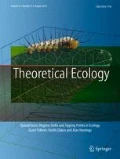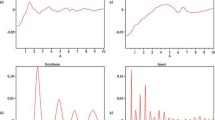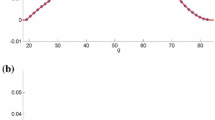Abstract
Population size and population growth rate respond to changes in vital rates like survival and fertility. In deterministic environments change in population growth rate alone determines change in population size. In random environments, population size at any time t is a random variable so that change in population size obeys a probability distribution. We analytically show that, in a density-independent population, the proportional change in population size with respect to a small proportional change in a vital rate has an asymptotic normal distribution. Its mean grows linearly at a rate equal to the elasticity of the long-term stochastic growth rate λ S while the standard deviation scales as \(\sqrt t\). Consequently, a vital rate with a larger elasticity of λ S may produce a larger mean change in population size compared to one with a smaller elasticity of λ S. But a given percentage change in population size may be more likely when the vital rate with smaller elasticity is perturbed. Hence, the response of population size to perturbation of a vital rate depends not only on the elasticity of the population growth rate but also on the variance in change in population size. Our results provide a formula to calculate the probability that population size changes by a given percentage that works well even for short time periods.





Similar content being viewed by others
References
Bengtsson K (1993) Fumana procumbens on Oland—population dynamics of a disjunct species at the northern limit of its range. Jr Ecol 81(4):745–758
Caswell H (2001) Matrix population models: construction, analysis and interpretation, 2nd edn. Sinauer, Sunderland
Chevin L-M (2010) On measuring selection in experimental evolution. Biol Lett 7:210–213
Claessen D (2005) Alternative life-history pathways and the elasticity of stochastic matrix models. Am Nat 165:E27–E35
Cohen JE (1977) Ergodicity of age structure in populations with Markovian vital rates, II. General states. Adv Appl Prob 9:18–37
Cowan CW, Smith BD (1993) New perspectives on a wild gourd in eastern North America. Jr Ethn Bot 13:17–54
Dennis B, Munholland PL, Scott JM (1991) Estimation of growth and extinction parameters for endangered species. Ecol Monogr 61:115–143
Fefferman NH, Reed JM (2006) A vital rate sensitivity analysis for nonstable age distributions and short-term planning. J Wildl Manage 70:649–656
Fox GA, Gurevitch J (2000) Population numbers count: tools for near-term demographic analysis. Am Nat 156:242–256
Gillespie JH (1973) Natural selection with varying selection coefficients—a haploid model. Gen Res 21:115–120
Haridas CV, Tuljapurkar S, Coulson T (2009) Estimating stochastic elasticities directly from longitudinal data. Ecol Lett 12:806–812
Lande R, Orzack SH (1988) Extinction dynamics of age-structured populations in a fluctuating environment. Proc Natl Acad Sci U S A 85:7418–7421
Maron JL, Horvitz CC, Williams JL (2010) Using experiments, demography and population models to estimate interaction strength based on transient and asymptotic dynamics. Jr Ecol 98:290–301
Morris WF, Doak DF (2002) Quantitative conservation biology: theory and practice of population viability analysis. Sinauer, Sunderland
Prendeville HR (2010) Ecological effects of virus-resistant transgenic squash. Unpublished Ph.D. dissertation, Graduate College at the University of Nebraska, Lincoln, NE
Ramula S, Knight TM, Burns JH, Buckley YM (2008) General guidelines for invasive plant management based on comparative demography of invasive and native plant populations. Jr. App Ecol 45:1124–1133
Tuljapurkar S (1990) Population dynamics in variable environments, vol 185. Lecture notes in biomathematics. Springer, New York
Tuljapurkar S, Horvitz CC, Pascarella JB (2003) The many growth rates and elasticities of populations in random environments. Am Nat 162:489–502
Vasseur DA, Yodzis P (2004) The color of environmental noise. Ecology 85:1146–1152
Wilson HD (1993) Free-living Cucurbita pepo in the United States: viral resistance, gene flow, and risk assessment. USDA Animal and Plant Health Inspection Service, Hyattsville
Author information
Authors and Affiliations
Corresponding author
Electronic Supplementary Material
Below is the link to the electronic supplementary material.
Rights and permissions
About this article
Cite this article
Haridas, C.V., Prendeville, H.R., Pilson, D. et al. Response of population size to changing vital rates in random environments. Theor Ecol 6, 21–29 (2013). https://doi.org/10.1007/s12080-011-0152-y
Received:
Accepted:
Published:
Issue Date:
DOI: https://doi.org/10.1007/s12080-011-0152-y




